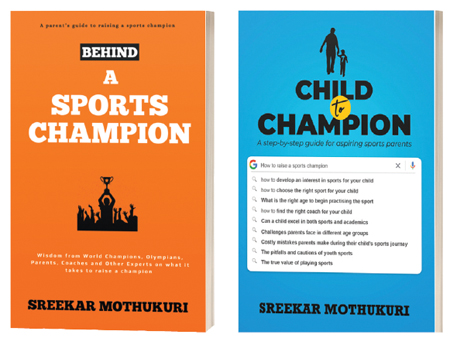Parenting: Cultivating a Love of Sports in Your Child

SREEKAR MOTHUKURI, a sports entrepreneur, coach, and multi-sport athlete, drives home the importance of why enrolling your child in sports is especially important for today’s generation, and how going about it the right way makes the difference between whether your child will hate it or love it.
There is a crucial difference in how this generation of children is growing up compared to previous ones. Most of us from previous generations grew up with rigorous physical activity and outdoor time. Playing games and unstructured sports in our neighborhoods like running, jumping, climbing trees, and playing games like hopscotch and hide-and-seek were built into our childhoods. Whether it was gully cricket in India or futsal—street soccer—in Brazil, kids all over the world naturally got exercise, fresh air, and important formative life lessons in interpersonal skills, teamwork, and so much more.
Not so with the present generation of kids that lives largely indoors. There is a considerable risk to their physical and mental health if parents are not able to counter this trend. Research done in the U.S. shows that 78 percent of people hospitalized during the pandemic have been obese. And that today’s children are the first generation ever to have a shorter life expectancy than their parents—by five years!
Many of today’s parents, especially Indian Americans who grew up in India a generation ago, took outdoor time and sports for granted. The thought of enrolling their children into organized sports activities may not come instinctively to them. But considering how things have changed, it has become extremely important to introduce sports to your children in an environment where it doesn’t come naturally.
The right time in your child’s life to introduce sports
In earlier generations, unstructured play and physical activity allowed kids to naturally learn age-appropriate motor skills. For today’s generation, it becomes important to help your child cultivate fundamental movement skills like running, jumping, leaping, hopping, rolling, sliding, catching, throwing, kicking, dribbling, and striking before enrolling the child into a sport. These movements are the building blocks for playing sports.
Soccer clubs like Manchester United and Chelsea have realized that the current generation lacks fundamental movement skills. The children do not know how to fall or roll, and consequently, get injured more often. So, they have hired parkour trainers to teach these fundamental movement skills to develop the competence and confidence to enjoy the sport better.
It is therefore advisable to wait until a child is around seven years old before introducing them to complex sports. Prior to that, a good way to prepare them is to expose them to activities like running, throwing/catching, swimming, gymnastics, and skating; or find a program that teaches fundamental movement skills.
If the child can run, they will take up soccer, basketball, volleyball, squash, etc. If the child can throw, they will take part in baseball, American football, etc. If the child can swim, they will be inclined towards competitive swimming, diving, water polo, scuba diving, etc.
What happens if you enroll the child in a sport without first teaching them fundamental movement skills? Unfortunately, often, with the intent of raising a champion, many parents start their child’s journey when they are as young as three to four years old. They keep them in a structured coaching environment and make them practice for two to three hours each day without understanding how children are, and what they can do (psychology and physiology), in different age groups.
As their tender bodies are still developing, overuse of muscles leads to injuries. Also, at that young age, they have limited attention spans and get burned out doing the same activity every day. But because they are young, they fear their parents and carry on for a while until they finally muster the courage to express their dislike.
Whether you want to raise your child to be a sports champion or just be healthy and active, a child will only continue a sport through their growing years if they actually enjoy it. Without the necessary fundamental movement skills, they will fumble. When a kid has not yet developed hand-eye coordination if you throw a tennis ball at them, they can’t instinctively judge the speed of the ball to be able to catch it or hit it. Most of the time, they overrun and miss the ball. They get frustrated and may lose interest in the sport.
Which sport to choose for your child?
When they are ready, there will be many sports for your child—baseball, cricket, soccer, American football, basketball, and so many more to choose from!

Parents need to understand their child’s unique personality to match them to the right sport or activity for them. Is the child more comfortable playing alone or in a group? Some children prefer to play team sports as they enjoy the camaraderie, while others, generally the introverted ones, prefer individual sports like tennis or squash. Some sports require speed and strength, and others demand flexibility and coordination. Some sports are easy to start with and some sports have an entry barrier.
A child that has a heightened fear of falling may not care much for gymnastics, just as a child who has a fear of water may avoid taking up swimming. This is not to say that some of these early phobias cannot be overcome by exposure but, generally speaking, a child will do better in sports that are naturally aligned with their personality.
Based on how the children are doing in fundamental movement skills as well as their personality, you will be able to understand which sport to start with. This way the child will have a positive experience of playing the sport.
The importance of exposure to multiple sports
If you want your child to pursue sports as a career or to find their interest, expose them to different sports and see which sport they are more inclined towards. Then you don’t need to worry about the child not showing interest or not focusing or being irregular to practices.
Along with identifying their interest, playing multiple sports has many benefits which will help them in their chosen sport as a career.
When we see Stephen Curry touch or AB de Villiers shots, we wonder how they do it. It’s because of the various sports they played as kids. What is common between Roger Federer, Rafael Nadal, Andy Murray, and Novak Djokovic? They all played soccer as kids growing up, and Novak Djokovic did skiing. That is the secret behind their strong legs and great footwork. Children who play multiple sports are physically and tactically more skilfull.
The value of sports extends far beyond the physical
Many people equate sports to physical activity or play them for getting fit. But sports also teach the importance of planning, preparation, focus, discipline, hard work, giving your best, etc. Children learn to work in teams, respect teammates and their opponents, adapt to different situations, and learn to deal with pressure, success, and failure. All these core values are important in any area of life, whether it is business, academics, or interpersonal relations.
In sports, an athlete faces many obstacles and setbacks. It’s never a smooth ride. Even after putting in the effort day in and day out physically and mentally, one may not get the desired results. You might play your best and still lose. You might get injured, you might not get selected for the team, you might be dropped from the team, you might get criticized, etc.
By playing sports, the players understand what they can control and what they cannot control before, during, and after the match. They focus on the controllable like planning, preparation, and giving their best in every practice and game. They treat each game as a learning experience. They are not worried about the uncontrollable—like the results, the critics, being dropped from the team, and so on.
So, playing sports is never a waste of time and money. It’s an investment for learning life and maintaining good health.
Sreekar Mothukuri left his high-paying corporate job as an engineer to pursue his passion for sports. He is the author of two books in the area of sports parenting: Behind a Sports Champion and Child to Champion: A step-by-step guide for aspiring sports parents.
Enjoyed reading Khabar magazine? Subscribe to Khabar and get a full digital copy of this Indian-American community magazine.
blog comments powered by Disqus










